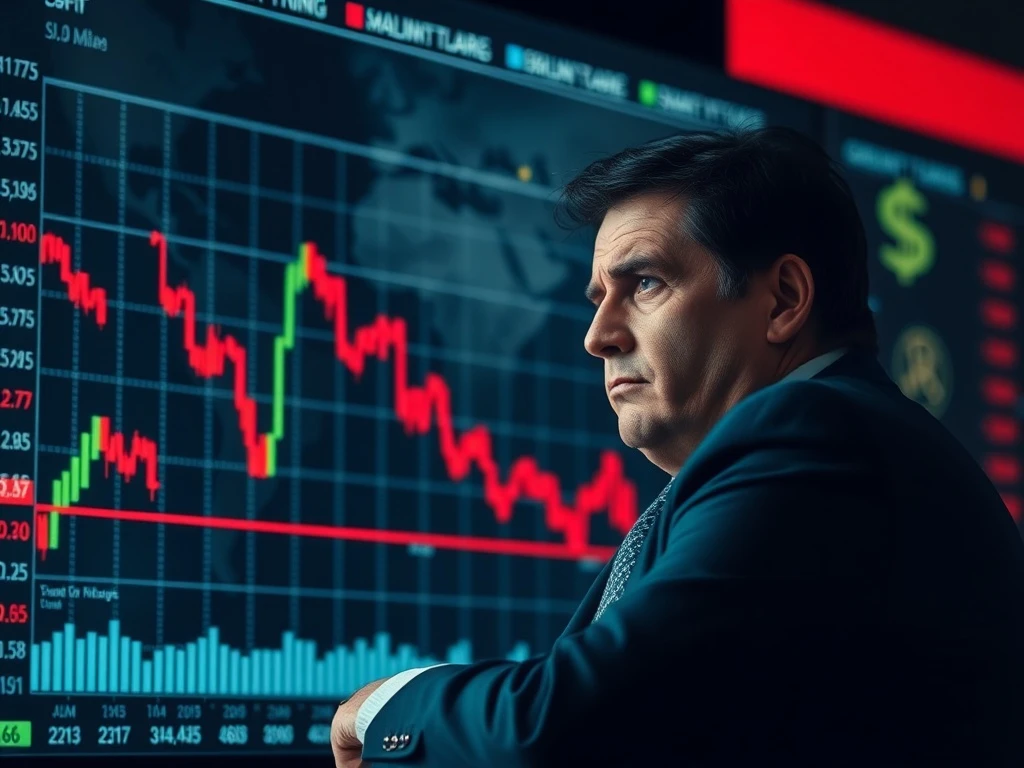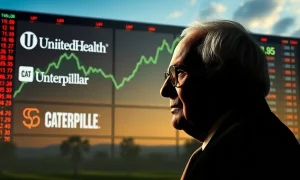The **tariffs impact** on global economies often goes underestimated by investors. Many financial professionals focus on immediate market movements. However, overlooking the long-term effects of trade barriers can lead to significant financial missteps. Tariffs are taxes imposed on imported goods. They represent a powerful tool of economic policy. Yet, their broader consequences are frequently ignored by those managing investment portfolios. This oversight creates a critical vulnerability. Investors must understand how these duties ripple through industries and national economies. Ignoring this complex dynamic is a grave error for unprepared investors.
Understanding the Tariffs Impact
Understanding the **tariffs impact** is fundamental for any investor. Tariffs are essentially taxes on goods imported from other countries. Governments impose them for various reasons. These reasons include protecting domestic industries, generating revenue, or influencing trade balances. There are different types of tariffs. For example, specific tariffs are fixed charges per unit. Ad valorem tariffs are a percentage of the imported good’s value. Compound tariffs combine both. Each type has a distinct effect on prices and trade volumes. Immediately, tariffs raise the cost of imported goods. This makes foreign products less competitive. Domestic goods may then seem more attractive. However, the effects rarely stop there. The true impact extends far beyond simple price adjustments. Businesses face increased operational costs. Consumers might see higher prices for everyday items. Furthermore, trade relationships can sour. This leads to retaliatory measures from other nations. Consequently, global trade flows can become severely disrupted.
Direct Costs and Consumer Prices
Tariffs directly increase the cost of imported goods. This is their most immediate effect. Importers must pay these taxes. They often pass these costs onto consumers. Therefore, prices for goods made with imported components can rise. Consider a company that manufactures cars. If tariffs are placed on imported steel, the cost of steel increases. This forces the car manufacturer to pay more for raw materials. To maintain profit margins, the company might raise car prices. Consumers then pay more for new vehicles. Similarly, tariffs on imported clothing can make apparel more expensive. This reduces consumer purchasing power. Over time, this can dampen overall economic activity. Businesses also face difficult choices.
- They might absorb the costs, which reduces their profits.
- Alternatively, they might shift production to different countries.
This can be a complex and expensive process. In essence, tariffs act as a hidden tax on consumers and businesses alike. The **tariffs impact** is felt directly in household budgets.
Ripple Effects Across Global Supply Chains
The **tariffs impact** extends far beyond direct costs. It creates significant ripple effects across global supply chains. Modern manufacturing relies on intricate international networks. Components often travel across multiple borders before reaching the final product. A tariff on one component can disrupt this entire system. For instance, a tariff on a specific electronic chip manufactured in one country affects devices assembled in another. The finished product then becomes more expensive. This forces companies to reconsider their sourcing strategies. They might seek new suppliers. This process is time-consuming and costly. It can also lead to lower quality inputs if alternatives are limited. Supply chains become less efficient. Furthermore, lead times for goods can increase. This causes delays in production and delivery. Businesses must adapt quickly. Some companies might choose to reshore production. This means bringing manufacturing back to their home country. However, reshoring involves substantial investment. It also requires access to skilled labor. The entire global production network experiences stress. Therefore, tariffs introduce uncertainty and volatility into international trade. This makes long-term planning much harder for businesses.
Impact on Specific Industries
Certain industries are particularly vulnerable to the **tariffs impact**. Industries relying heavily on imported raw materials or components suffer significantly. The automotive industry, for example, often sources parts globally. Tariffs on steel, aluminum, or specialized electronics can drastically increase production costs. This makes cars more expensive for consumers. The technology sector also faces challenges. Many electronic devices depend on a complex web of international suppliers. Tariffs on semiconductors or rare earth minerals can disrupt manufacturing. This affects everything from smartphones to computers. Agriculture is another sensitive area. Retaliatory tariffs from other countries can severely limit export markets. Farmers might lose access to key buyers. This leads to lower prices for their produce. Consider the impact on soybean farmers.
- If a major importing country imposes retaliatory tariffs, soybean exports drop.
- Farmers then struggle to sell their crops.
- This can lead to financial hardship.
Therefore, the effects are not uniform. Some sectors absorb the shock better than others. Others face existential threats. Understanding these sector-specific vulnerabilities is crucial for investors. It helps in assessing risk within a diversified portfolio.
The Macroeconomic Picture: Growth and Inflation
Investors often fail to grasp the broader macroeconomic **tariffs impact**. Tariffs can significantly influence both economic growth and inflation. When tariffs increase the cost of imported goods, domestic producers may face less competition. This could lead to higher prices for their products too. Consequently, overall inflation can rise. Higher inflation erodes purchasing power. It also puts pressure on central banks to raise interest rates. Higher interest rates can slow economic activity. Furthermore, tariffs can reduce overall trade volumes. Less trade means fewer goods and services are exchanged globally. This can directly hinder economic growth. Businesses might delay investment decisions. They may become uncertain about future trade policies. Consumer spending could also decline due to higher prices. The aggregate effect is a slowdown in economic expansion. A trade war, characterized by escalating tariffs, amplifies these negative effects. It creates a climate of unpredictability. This discourages both domestic and international investment. Therefore, the potential for a global economic slowdown increases. This broader economic risk is often underestimated by investors focusing solely on company-specific news.
Currency Fluctuations and Trade Imbalances
The **tariffs impact** extends to currency markets and trade balances. Tariffs can influence a country’s currency value. When a country imposes tariffs, it aims to reduce imports and boost exports. This can theoretically strengthen its currency. However, retaliatory tariffs can complicate this. If other countries impose similar duties, the original country’s exports might fall. This could weaken its currency. For example, if the US places tariffs on Chinese goods, and China retaliates, US exports to China may decrease. This could put downward pressure on the US dollar relative to the Yuan, depending on various factors. Furthermore, tariffs aim to address trade imbalances. A country with a large trade deficit might use tariffs to reduce imports. However, the effectiveness is debatable. Tariffs can lead to a shift in trade, not necessarily a reduction in the deficit. Imports might just come from different countries. Also, retaliatory tariffs can create new imbalances. For investors, currency fluctuations are critical. A weaker domestic currency makes imports more expensive. It makes exports cheaper. This affects the profitability of international companies. Therefore, understanding these complex interactions is vital for managing foreign exchange risk. The interplay between tariffs, currency, and trade deficits forms a complex web.
Investor Blind Spots: Why Tariffs Are Overlooked
Despite their significant potential, the **tariffs impact** is often overlooked by many investors. Several factors contribute to this blind spot. Firstly, tariffs can seem like a distant, abstract policy issue. Investors often prioritize immediate corporate earnings reports or market sentiment. They might view tariffs as a political matter rather than an economic one. Secondly, the full effects of tariffs are not always immediate. They unfold over months or even years. This long-term horizon can be challenging for investors focused on short-term gains. Many market participants operate on quarterly or even daily cycles. They may miss the gradual erosion of economic fundamentals. Thirdly, the complexity of global supply chains makes analysis difficult. Tracing the full cost implications across numerous industries requires deep research. Few investors have the resources or time for such detailed analysis. Finally, there is a tendency to dismiss tariffs as temporary. Policymakers can reverse them. However, even temporary tariffs can cause lasting damage to trade relationships and supply chains. This “wait and see” approach can be dangerous. It prevents proactive risk management. Investors often fall into the trap of confirmation bias. They seek information that confirms their existing views. This can lead them to ignore warning signs related to trade policy.
Short-Term Focus vs. Long-Term Damage
A significant reason for underestimating the **tariffs impact** is the prevalent short-term market focus. Investors often react to immediate news cycles. They prioritize quarterly earnings or central bank announcements. These factors drive daily stock price movements. However, tariffs inflict long-term damage. They reshape global trade routes. They force companies to re-evaluate their entire business models. For example, a company might initially absorb tariff costs to maintain market share. This impacts their profit margins over several quarters. Eventually, they might have to raise prices or cut production. This long-term strategic shift is not always reflected in short-term stock performance. Furthermore, tariffs can foster an environment of uncertainty. This discourages long-term capital investment. Businesses become hesitant to build new factories or expand operations. Such delays stifle innovation and productivity growth. The cumulative effect of these delays can be substantial. Yet, daily market fluctuations often overshadow these underlying structural changes. Investors must therefore shift their perspective. They need to consider the enduring consequences of trade policy. This requires a more patient and strategic approach to investment. Failing to do so can lead to unexpected losses down the line.
Strategies for Navigating Tariffs Impact
Navigating the **tariffs impact** requires a proactive and informed investment strategy. Investors cannot afford to ignore these significant economic forces. One key strategy involves thorough research. Understand which industries and companies are most exposed to tariff risks. Examine their supply chains. Identify their reliance on imported components or export markets. This granular analysis provides a clearer picture of potential vulnerabilities. Furthermore, consider the political landscape. Trade policies can change rapidly. Staying informed about international relations and diplomatic developments is crucial. Look for signals of escalating trade tensions. Conversely, identify opportunities for de-escalation.
- Diversification remains a cornerstone of risk management.
- Spread investments across different sectors and geographies.
- This reduces concentration risk.
If one sector is hit hard by tariffs, others might remain resilient. Investors should also consider companies with strong domestic markets. These firms may be less exposed to international trade disruptions. Alternatively, look for companies with flexible supply chains. Firms that can quickly adapt their sourcing or production locations are better positioned. Regular portfolio reviews are essential. Adjust holdings as new tariff policies emerge. A dynamic approach is necessary in a volatile global trade environment.
Diversification and Sector-Specific Analysis
Effective diversification is paramount when facing the **tariffs impact**. Do not put all your eggs in one basket. Spreading investments across various industries helps mitigate risk. For example, if tariffs heavily affect manufacturing, a portfolio balanced with service-oriented companies might fare better. Similarly, geographical diversification is important. Invest in companies operating in multiple countries. This reduces exposure to tariffs imposed by a single nation. A company with diversified revenue streams across different markets is more resilient. Beyond broad diversification, conduct sector-specific analysis. Identify industries that are net importers versus net exporters. Tariffs typically hurt net importers more. They benefit domestic producers in protected industries. For instance, a tariff on imported steel could benefit domestic steel producers. However, it harms industries that use steel as an input. Understand the specific vulnerabilities and opportunities within each sector. Consider the competitive landscape. Are there domestic alternatives for tariffed goods? Can companies easily shift their supply chains? These detailed questions help uncover hidden risks and potential gains. Such deep dives ensure a more robust investment portfolio. This proactive approach helps to buffer against trade policy shocks.
Monitoring Policy Shifts and Geopolitical Tensions
Vigilant monitoring of policy shifts and geopolitical tensions is crucial for understanding the **tariffs impact**. Trade policy is not static. It evolves with political changes and international relations. Investors must pay close attention to government announcements. Read trade negotiation updates. Understand the rhetoric from key political figures. Geopolitical events often trigger tariff actions. For example, disputes over intellectual property or national security concerns can lead to new trade barriers. Monitoring these tensions provides early warning signs. Look beyond official statements. Analyze the underlying economic and political motivations. Are countries using tariffs as a bargaining chip? Are they signaling a long-term shift in trade strategy? Consider the potential for retaliatory measures. When one country imposes tariffs, others often respond in kind. This can escalate into a trade war. A trade war harms all participants. Therefore, staying informed about diplomatic relations is as important as tracking economic data. Utilize reputable news sources and expert analyses. Subscribe to economic policy updates. This proactive approach allows investors to anticipate changes. It enables timely adjustments to investment portfolios. Ignoring these signals is a significant oversight. It leaves portfolios vulnerable to unexpected trade shocks.
In conclusion, the **tariffs impact** is a multifaceted economic force. It profoundly influences global trade, specific industries, and macroeconomic stability. Investors who underestimate or ignore these effects are making a grave mistake. The immediate costs, supply chain disruptions, and broader economic consequences are too significant to overlook. While tariffs may seem like a distant policy matter, their ripple effects are tangible. They affect corporate profits, consumer prices, and national growth rates. A short-term focus often blinds investors to the long-term damage tariffs can inflict. Therefore, a proactive and informed approach is essential. Investors must understand the mechanics of tariffs. They need to analyze their sector-specific vulnerabilities. Furthermore, they must adopt robust strategies like diversification and continuous monitoring of geopolitical developments. By doing so, investors can better navigate the complexities of global trade. They can protect their portfolios from unforeseen trade shocks. Ignoring the profound **tariffs impact** is no longer a viable option for serious investors. It is time to integrate this critical factor into every investment decision.
Frequently Asked Questions (FAQs)
Q1: What exactly are tariffs and how do they impact prices?
Tariffs are taxes imposed on imported goods. They directly increase the cost of these goods for importers. Importers often pass these higher costs onto consumers. This results in higher prices for products made with imported materials or components. This direct **tariffs impact** can reduce consumer purchasing power and increase inflation.
Q2: How do tariffs affect global supply chains?
Tariffs significantly disrupt global supply chains. Modern production relies on components sourced internationally. A tariff on one part can make the entire product more expensive. Companies might then seek new suppliers or reshore production. This leads to inefficiencies, increased costs, and potential delays in manufacturing and delivery.
Q3: Why do investors often overlook the impact of tariffs?
Investors often overlook the **tariffs impact** due to several reasons. They may view tariffs as a political issue rather than an economic one. The full effects unfold gradually over time, making them less immediate. The complexity of global supply chains also makes analysis difficult. Additionally, some investors might dismiss tariffs as temporary, leading to a “wait and see” approach.
Q4: Which industries are most vulnerable to tariffs?
Industries heavily reliant on imported raw materials or components are most vulnerable. Examples include the automotive sector (steel, aluminum, electronics) and the technology sector (semiconductors, rare earth minerals). Export-oriented industries, like agriculture, also face significant risks from retaliatory tariffs imposed by other countries.
Q5: What strategies can investors use to mitigate tariff risks?
Investors can employ several strategies. These include thorough research into company supply chains and market exposure. Diversifying investments across various sectors and geographies helps spread risk. Focusing on companies with strong domestic markets or flexible supply chains can also reduce vulnerability. Continuous monitoring of trade policy and geopolitical developments is also crucial.
Q6: Can tariffs lead to a global economic slowdown?
Yes, tariffs can contribute to a global economic slowdown. By increasing costs, reducing trade volumes, and fostering uncertainty, tariffs can hinder economic growth. Escalating trade wars can discourage investment, reduce consumer spending, and potentially lead to higher inflation. This combined **tariffs impact** can significantly dampen global economic expansion.
























